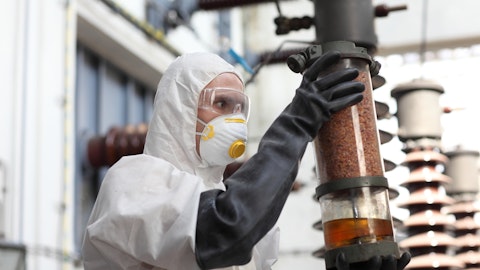Todd Slater: Yes. We have an investment-grade balance sheet today. We have one of the three rating agencies that rate us investment grade, where our results are and expected to be for the year. Our debt level as where we ended last year is consistent with our expectation for the end of this year. So we don’t need to have any structural debt repay.
Duffy Fischer: Great. Thank you, guys.
Operator: Our next question comes from Josh Spector from UBS. Please go ahead with your question.
Josh Spector: Hi, thanks for taking my question. And echo my congrats, Ken. So I just wanted to follow-up again on the guidance. So if we’re talking about 2Q less than $300 million, I guess, to hit that range, you’re going to need a quarter greater than $400 million, probably later in the year. I guess – I mean, it seemed like your question – you are answered before was that you expect pricing to move up through the year to do that, but you’ve also talked about increasing demand. So if you think about bridging that $100 million step up from, call it, 2Q to let’s say, 4Q, how would you bracket that between assumptions on pricing versus volumes?
Ken Lane: Well, first, you’re correct with your math, and I’m not giving you a specific number around Q2. So I want to be careful with that. I would put it more of a range that would say, again, it could be slightly better than the step-up from Q4. And a lot of that is going to depend on the volume recovery that we see coming. The mix between volume and price is probably a little bit more volume coming back in CATV, but we’ve got the momentum from pricing that we saw at the end of Q1. So that combined with continued pricing step-ups in chlor alkali is going to be the biggest driver there. The bigger driver for Epoxy is going to be mix. It’s going to be the improved margin with the portfolio that we’re going to see in Q2.
Josh Spector: Thanks, Ken. If I could just ask, I mean, there’s been some comments on the news about the St. Grade Bureau ramp-up and maybe some choppiness there. Does that have any headwind in 2Q that you call out or in 1Q at all?
Ken Lane: No. We’ve got a system that’s operating relatively low utilization rates. And so we’re able to flex our system to be able to make up for any shortfalls that at whatever site may have an upset. We can adjust for that in our system. So I don’t expect there to be anything to impact our Q2 results there.
Josh Spector: Okay, thank you.
Ken Lane: Sure.
Operator: Our next question comes from Arun Viswanathan from RBC Capital Markets. Please go ahead with you question.
Arun Viswanathan: Great. Thanks. I just wanted to ask a couple of questions. Maybe first on and congratulations Ken. Good to hear your voice again. So just on the Parley Index, it looks like that ticked down in the quarter, was that maybe due to your own efforts of selling into the market? Or was it maybe also an inflection point in volumes? Or how do you kind of characterize the parlay activity. Thanks.
Ken Lane: Thanks, Arun. I mean, listen, that’s a reflection of what we have talked about, which is the market around caustic is higher than people believe. I can tell you that our inventory levels are very low, and we believe that the industry is low as well. And so you’re seeing a little bit of an adjustment there, those parlay volumes. And be careful with that because those volumes are going to move around based on things that are much more broad than just our portfolio moves, right? So – but we do see the market being tighter for caustic. And I think that’s what you’re seeing reflected in that parlay volume.
Arun Viswanathan: Great. And then just given the expectation that you will be exiting the second half or maybe the second half EBITDA, you do hit that $1.3 billion plus will be on the order of $700 million to $800 million – is that kind of a fair starting point for first half next year? Would that really be an indication that volumes are approaching a more normal level? And I guess my only concern there would be, would that require Epoxy also to get materially better? Or can you get there with mainly chlor alkali improvement?
Ken Lane: Yes, thanks, Arun. Listen, I would say that it’s – to start talking about what’s going to happen that far out with the amount of uncertainty in the world today would not be prudent, right? I mean we’ve got A lot of things that are going to happen between now and even the fourth quarter, we need to see how that plays out and how the global economy develops. But again, in the short-term, we are seeing improvement in demand. Beyond that, it’s really too early to make any calls on what the first half of next year might look like.
Arun Viswanathan: Okay. And then one quick one, if I could. Just on the shareholder returns. What’s kind of a comfortable floor of buybacks that we should assume for this year, maybe in the $500 million to $600 million range or actually frame that? Thanks.
Ken Lane: Well, I mean, we – what we have said previously is we will be a steady buyer of our shares. I am not going to give you any prediction now on the amount that we would purchase. Todd, do you want to add anything to that?
Todd Slater: You saw the level of purchases we did in the first quarter, roughly $105 million. And given our levered free cash flow forecast, we are a steady buyer, you can make your own assumptions. But that’s really our primary use of levered free cash flow other than a regular dividend that we pay. That’s where you would expect that to be used Arun.
Arun Viswanathan: Thanks.
Ken Lane: Thanks Arun.
Operator: Our next question comes from Mike Sison from Wells Fargo. Please go ahead with your question.
Mike Sison: Hey. Nice start to the year. Ken, welcome on Board. Just curious, and I know it might be a little bit early to comment, but if you think about what Olin’s mid-cycle EBITDA potential and maybe peak EBITDA potential, do you have any thoughts of maybe where or how you can sort of get there and what levels those EBITDA or earnings could get to?
Ken Lane: Thank you, Mike. Listen, I – what I will say is that Olin has been very successful in resetting the cycle, which is great to see. Where we are at now and the trough is above the prior peak, and we do believe that is durable. I don’t have a view that I would give you right now in terms of a mid-cycle level for Olin. I don’t – maybe we will get to that when we have our Investor Day later this year, but nothing really to elaborate on at this point.
Mike Sison: Understood. Yes, looking forward to that Analyst Day in Cleveland, right? No, I am joking. But sort of a follow-up in terms of sort of the setup for 2Q and second half of the year, so it sounds if the step-up in 2Q versus 1Q is better than the first quarter or the fourth quarter. It doesn’t sound like you will be above $300 million. I know you want a specific guidance. But I guess the part of the question is, what operating rate do you need to get to in the second half to sort of get to that much higher EBITDA level to do the one through yourself [ph] for full year?
Ken Lane: Well, again, I know we want to focus on operating rates, but there is more than just the operating rates for chlor alkali that we need to think about. There will be some increase in the operating rate, obviously, as we see the demand come back. But don’t forget about the important role that our Winchester business is going to play. We are going to see that improve through the year. We are going to see epoxy continue to improve through the year. So, it’s more than just focusing on that operating rate. We will adjust the operating rate to match the demand that we see. And obviously, if the demand is coming back with our inventories being low, operating rates will step up. But that’s only one part of that equation to get to the higher level in the back half of the year.
Mike Sison: Alright. Thank you.
Ken Lane: Sure. Thanks.
Operator: Our next question comes from Matthew Blair from TPH. Please go ahead with your question.
Matthew Blair: Good morning and congrats Ken. There has been a lot of commentary on just the positive demand trends that you are seeing. Could you provide any more color on which end markets are relatively stronger and which end markets are relatively weaker? Just thinking about areas like pulp and paper, alumina, and then I guess more on the construction side.
Ken Lane: Yes. Well, like we have said in the prepared remarks, we are seeing improving demand in agriculture, titanium oxide, polyurethanes, which go into a lot of different end markets. I would say, in general, that the area that we are not seeing the improvement yet is around construction. That’s a very big driver for our businesses. So, things like electronics and even wind energy, we are going to start to see some improvement there. But a big market for us is construction, and we are not seeing improvement in that market yet. And I will just comment related to that is China and what we see happening in China. There have been some very small improvements that we see in China, but we are not seeing anything structural improved there yet. And for us to really see a global improvement in some of our commodity flows, we need to see China start to grow more. So, that’s still something we are watching very closely is what’s happening in that market.
Matthew Blair: Okay. And the – I guess the tepid numbers in construction, does that help explain why spot EDC prices are a little bit lower in Q2 versus Q1, or are there other dynamics at play?
Ken Lane: I am sorry, you said spot, what prices?
Matthew Blair: Spot EDC.
Ken Lane: EDC, okay. I am sorry. I didn’t follow what you were saying. Yes, so I think what we saw in the first quarter, there was some volume getting pushed into the market just because of operating offsets. We actually saw some improvement in our portfolio and pricing there. But I think that is going to normalize as the assets that are producing get back to a normal level of operations and not trying to adjust for an upswing that’s not necessarily as strong as what was thought previously.
Matthew Blair: Great. Thanks for your comments.
Ken Lane: Good. Thank you, Matthew.
Operator: Our next question comes from Kevin McCarthy from Vertical Research Partners. Please go ahead with your question.
Kevin McCarthy: Thank you and good morning. And Ken welcome, good to hear your voice as well. My question relates to energy. Obviously, natural gas prices have been very favorable lately south of $2 per MMBtu. Can you talk about Olin’s hedge positioning to what degree – have you locked in these low prices, or might the exposure be more freely floating as we think about how ECU values or margins may trend moving forward?
Ken Lane: Thank you, Kevin. Yes. So, we have talked about this before. Our hedge strategy is we tend to hedge a pretty high percentage in the current quarter and then that will gradually step down in the next three quarters. So, we were – in the first quarter, we were very highly hedged in terms of a percentage of our portfolio and we continue to do that in the second quarter. So, we won’t see as much benefit in the lower energy prices that you see today in the market. We will see some of that, but our hedging strategy is really to avoid the pain of the peaks and the shocks that you see. Todd, do you want to add to that?





